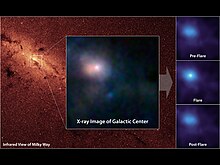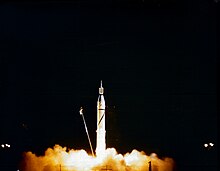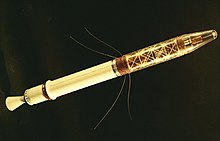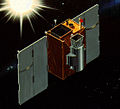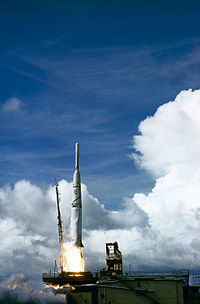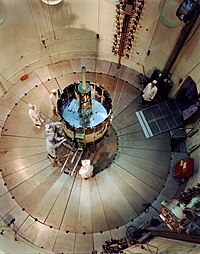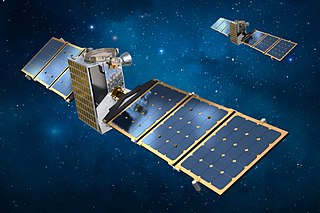| No. | Name(s) | Launch date (UTC) | Rocket | Mass (kg) | Orbit regime | End of data | Re-entry
[59] | Mission/Notes |
|---|
| 1 | Explorer 1 | 1 February 1958 | Juno I | 14 | MEO | 23 May 1958 | 31 March 1970 | First American satellite, third satellite to achieve orbit; discovered the Van Allen radiation belt; launched by the U.S. Army [60] |
|---|
| 2 | Explorer 2 | 5 March 1958 | Juno I | 15 | Failed | — | — | Failed to achieve orbit. [61] |
|---|
| 3 | Explorer 3 | 26 March 1958 | Juno I | 14 | MEO | 27 June 1958 | 27 June 1958 | Energetic particle studies helped confirm the presence of Van Allen radiation belt [62] |
|---|
| 4 | Explorer 4 | July 26, 1958 | Juno I | 26 | MEO | October 5, 1958 | October 23, 1959 | Monitor charged particles inside Van Allen belts from nuclear detonations (during Operation Argus) [63] |
|---|
| 5 | Explorer 5 | August 24, 1958 | Juno I | 17 | failed | — | — | Planned in conjunction with Explorer 4, but launch failed [64] |
|---|
| — | Explorer S-1 (7X) | July 16, 1959 | Juno II | 42 | failed | — | — | Planned to measure Earth's radiation balance, but destroyed within seconds by range safety [65] |
|---|
| 6 | Explorer 6 (S-2, Able 3) | August 7, 1959 | Thor-Able | 64 | HEO | October 6, 1959 | July 1, 1961 | Magnetosphere research and digital telemetry; first NASA launch, first Earth photo from orbit [66] [67] |
|---|
| 7 | Explorer 7 (S-1A) | October 13, 1959 | Juno II | 42 | LEO | August 24, 1961 | In orbit | Micrometeoroids and energetic particle studies, first satellite to measure Earth's climate [68] [69] [70] |
|---|
| – | S-46A (IE-B) | March 23, 1960 | Juno II | 16 | failed | — | — | Analyze electron and proton radiation energies, failed to achieve orbit [71] |
|---|
| 8 | Explorer 8 (S-30) | 3 November 1960 | Juno II | 41 | LEO | 27 December 1960 | 27 March 2012 | Measured atmospheric composition of the ionosphere [72] |
|---|
| – | S-56 | December 4, 1960 | Scout X-1 | 6 | failed | — | — | Atmosphere density measurement, but failed to achieve orbit [73] |
|---|
| 9 | Explorer 9 (S-56A) | February 16, 1961 | Scout X-1 | 36 | LEO | April 9, 1964 | April 9, 1964 | Atmospheric density measurements, first spacecraft placed in orbit by a solid-fuel rocket [74] |
|---|
| – | S-45 | February 24, 1961 | Juno II | 34 | failed | — | — | Ionosphere research, but failed to achieve orbit [75] |
|---|
| 10 | Explorer 10 (P 14) | March 25, 1961 | Thor-Delta | 79 | HEO | March 25, 1961 | June 1, 1968 | Investigated the magnetic field between the Earth and Moon [76] |
|---|
| 11 | Explorer 11 (S 15) | April 27, 1961 | Juno II | 37 | LEO | November 17, 1961 | In orbit | Gamma ray astronomy [77] |
|---|
| – | S-45A | May 25, 1961 | Juno II | 34 | failed | — | — | Ionosphere research, failed to achieve orbit. Last Juno II launch. [78] |
|---|
| – | S-55 (satellite) (Meteoroid Satellite-A, Micrometeorite Explorer) | June 30, 1961 | Scout X-1 | 85 | failed | — | — | Micrometeoroid research, failed to achieve orbit [79] |
|---|
| 12 | EPE-A (S 3, Energetic Particle Explorer-A) | August 16, 1961 | Thor-Delta | 38 | HEO | December 6, 1961 | September 1, 1963 | Energetic particle research [80] |
|---|
| 13 | S-55A | August 25, 1961 | Scout X-1 | 86 | LEO | August 28, 1961 | August 28, 1961 | Micrometeoroid research; partial failure [81] |
|---|
| 14 | EPE-B (Energetic Particle Explorer-B) | October 2, 1962 | Delta A | 40 | HEO | August 11, 1963 | July 1, 1966 | Energetic particle research [82] |
|---|
| 15 | EPE-C (S-3B, Energetic Particle Explorer-C) | October 27, 1962 | Delta A | 44 | HEO | January 30, 1963 | January 15, 1978 | Energetic particle research [83] |
|---|
| 16 | S-55B | December 16, 1962 | Scout X-3 | 101 | LEO | July 22, 1963 | In orbit | Micrometeoroid research [84] |
|---|
| 17 | AE-A (S-6, Atmosphere Explorer-A) | April 3, 1963 | Delta B | 184 | LEO | July 10, 1963 | November 24, 1966 | Atmospheric research [85] |
|---|
| 18 | IMP-A (IMP 1, Interplanetary Monitoring Platform-A) | November 27, 1963 | Delta C | 138 | HEO | May 10, 1965 | December 30, 1965 | Magnetospheric research [86] |
|---|
| 19 | AD-A (Atmospheric Density-A) | December 19, 1963 | Scout X-4 | 8 | LEO | May 10, 1981 | May 10, 1981 | Atmospheric density measurements [87] |
|---|
| – | BE-A (Beacon Explorer-A, S-66A) | March 19, 1964 | Delta B | 114 | failed | — | — | Launch failure [88] |
|---|
| 20 | IE-A (S 48, TOPSI, Ionosphere Explorer-A) | August 25, 1964 | Scout X-4 | 45 | LEO | December 29, 1965 | In orbit | Ionosphere research [89] |
|---|
| 21 | IMP-B (IMP 2, Interplanetary Monitoring Platform-B) | October 4, 1964 | Delta C | 135 | HEO | October 13, 1965 | January 30, 1966 | Magnetospheric research [90] |
|---|
| 22 | BE-B (Beacon Explorer-B, S-66B) | October 10, 1964 | Scout X-4 | 53 | LEO | February 1970 | In orbit | Ionospheric and geodetic research [91] |
|---|
| 23 | S 55C | November 6, 1964 | Scout X-4 | 134 | LEO | November 7, 1965 | June 29, 1983 | Micrometeoric research [92] |
|---|
| 24 | AD-B (Atmospheric Density-B) | November 21, 1964 | Scout X-4 | 9 | MEO | October 18, 1968 | October 18, 1968 | Atmospheric density measurements [93] |
|---|
| 25 | Injun 4 (IE-B, Ionosphere Explorer-B) | November 21, 1964 | Scout X-4 | 40 | LEO | December 1966 | In orbit | Ionospheric research [94] |
|---|
| 26 | EPE-D (Energetic Particle Explorer-D) | December 21, 1964 | Delta C | 46 | MEO | December 27, 1967 | August 23, 2021 | High energy particle observations [95] |
|---|
| 27 | BE-C (Beacon Explorer-C,S-66C) | April 29, 1965 | Scout X-4 | 61 | LEO | July 20, 1973 | In orbit | Magnetospheric research [96] |
|---|
| 28 | IMP-C (IMP 3, Interplanetary Monitoring Platform-C) | May 29, 1965 | Delta C | 128 | HEO | May 12, 1967 | July 4, 1968 | Magnetospheric research [97] |
|---|
| 29 | GEOS 1 (GEOS-A, Geodetic Earth Orbiting Satellite-1) | November 6, 1965 | Delta E | 387 | LEO | June 23, 1978 | In orbit | Geodetic Earth monitoring [98] |
|---|
| 30 | SOLRAD 8 (SE-A) | November 19, 1965 | Scout X-4 | 57 | LEO | November 5, 1967 | In orbit | Solar radiation monitoring (Cover for covert ELINT mission) [99] |
|---|
| 31 | DME-A (Direct Measurements Explorer) | November 29, 1965 | Thor-Agena B | 99 | LEO | October 1, 1969 | In orbit | Ionospheric research [100] |
|---|
| 32 | AE-B (Atmosphere Explorer-B) | May 25, 1966 | Delta C1 | 225 | LEO | March 1967 | February 22, 1985 | Atmospheric research [101] |
|---|
| 33 | IMP-D (AIMP 1, Interplanetary Monitoring Platform-D) | July 1, 1966 | Delta E1 | 212 | HEO | September 21, 1971 [102] | In orbit | Magnetospheric research |
|---|
| 34 | IMP-F (IMP 4, Interplanetary Monitoring Platform-F) | May 24, 1967 | Delta E1 | 163 | MEO | May 3, 1969 | May 3, 1969 | Magnetospheric research [103] |
|---|
| 35 | IMP-E (AIMP 2, Interplanetary Monitoring Platform-E) | July 19, 1967 | Delta E1 | 230 | Lunar | June 24, 1973 | Lunar orbit | Magnetospheric research [104] |
|---|
| 36 | GEOS 2 (GEOS-B, Geodetic Earth Orbiting Satellite-2) | January 11, 1968 | Delta E1 | 469 | LEO | July 1, 1982 | In orbit | Geodetic Earth monitoring [105] |
|---|
| 37 | SOLRAD 9 (SE B) | March 5, 1968 | Scout B | 198 | LEO | April 30, 1974 | November 16, 1990 | Solar radiation monitoring
(Cover for covert ELINT mission) [106] |
|---|
| 38 | RAE-A (RAE 1, Radio Astronomy Explorer-A) | July 4, 1968 | Delta J | 602 | MEO | (~1969) | In orbit | Radio astronomy [107] |
|---|
| 39 | AD-C (Atmospheric Density-C) | August 8, 1968 | Scout B | 9 | LEO | June 23, 1971 | June 22, 1981 | Atmospheric density measurements [108] |
|---|
| 40 | Injun 5 (Injun C, IE-C, Ionosphere Explorer-C) | August 8, 1968 | Scout B | 71 | LEO | June 1971 | In orbit | Magnetospheric Research [109] |
|---|
| 41 | IMP-G (IMP 5, Interplanetary Monitoring Platform-G) | June 21, 1969 | Delta E1 | 145 | HEO | December 23, 1972 | December 23, 1972 | Magnetospheric research [110] |
|---|
| 42 | Uhuru (SAS-A, SAS 1) | December 12, 1970 | Scout B | 142 | LEO | January 4, 1975 | April 5, 1979 | X-ray astronomy [111] |
|---|
| 43 | IMP-H (IMP 7, Interplanetary Monitoring Platform-H) | March 13, 1971 | Delta M6 | 635 | MEO | October 2, 1974 | October 2, 1974 | Magnetospheric research [112] |
|---|
| 44 | SOLRAD 10 (SE-C, SOLRAD-C) | July 8, 1971 | Scout B | 260 | LEO | June 30, 1973 | December 15, 1979 | Solar radiation monitoring
(Cover for covert ELINT mission) [113] |
|---|
| 45 | SSS-A (S-Cubed A) | November 15, 1971 | Scout B | 52 | MEO | September 30, 1974 | January 10, 1992 | Magnetospheric research [114] |
|---|
| 46 | MTS (Meteoroid Technology Satellite, METEC) [115] | August 13, 1972 | Scout D-1 | 90 | LEO | November 4, 1974 | November 2, 1979 | Micrometeoroids research [116] |
|---|
| 47 | IMP-I (IMP 6, Interplanetary Monitoring Platform-I) | September 23, 1972 | Delta 1604 | 635 | HEO | October 31, 1978 | In orbit | Magnetospheric research [117] |
|---|
| 48 | SAS-B (Small Astronomy Satellite-B, SAS 2) | November 15, 1972 | Scout D-1 | 166 | LEO | June 8, 1973 | August 20, 1980 | X-ray astronomy [118] |
|---|
| 49 | RAE-B (RAE 2, Radio Astronomy Explorer-B) | June 10, 1973 | Delta 1913 | 328 | Lunar | April 26, 1977 | Presumed crashed into Moon sometime after August 1977 [119] | Radio astronomy [119] |
|---|
| 50 | IMP-J (IMP 8, Interplanetary Monitoring Platform-J) | October 26, 1973 | Delta 1604 | 371 | HEO | October 7, 2006 | In orbit | Magnetospheric research [120] |
|---|
| 51 | AE-C (Atmosphere Explorer-C) | December 16, 1973 | Delta 1900 | 658 | LEO | (December 12, 1978) | December 12, 1978 | Atmospheric research [121] |
|---|
| 52 | Hawkeye 1 (Injun-F, Injun 6, IE-D, Ionosphere Explorer-D) | June 3, 1974 | Scout E-1 | 23 | HEO | April 28, 1978 | April 28, 1978 | Magnetospheric research [122] |
|---|
| 53 | SAS-C (Small Astronomy Satellite-C, SAS 3) | May 7, 1975 | Scout F-1 | 197 | LEO | April 7, 1979 | April 9, 1979 | X-ray astronomy [123] |
|---|
| 54 | AE-D (Atmosphere Explorer-D) | October 6, 1975 | Delta 2910 | 681 | LEO | January 29, 1976 | March 12, 1976 | Atmospheric research [124] |
|---|
| 55 | AE-E (Atmosphere Explorer-E) | November 20, 1975 | Delta 2910 | 735 | LEO | September 25, 1980 | June 10, 1981 | Atmospheric research [125] |
|---|
| — | DADE-A (Dual Air Density Explorer-A) | December 5, 1975 | Scout F-1 | 40 | failed | — | — | Atmospheric research; failed during launch [126] |
|---|
| — | DADE-B (Dual Air Density Explorer-B) | December 5, 1975 | Scout F-1 | 43 | failed | — | — | Atmospheric research; failed during launch [127] |
|---|
| 56 | ISEE-1 (ISEE-A) | October 22, 1977 | Delta 2914 | 340 | HEO | September 26, 1987 | September 26, 1987 | Magnetospheric research; launched with ESA's ISEE-2; co-mission with ISEE 3 [128] |
|---|
| 57 | IUE | January 26, 1978 | Delta 2914 | 669 | MEO | September 30, 1996 | In orbit | Ultraviolet astronomy [129] |
|---|
| 58 | HCMM (AEM-A) | April 26, 1978 | Scout F | 117 | LEO | September 30, 1980 | December 22, 1981 | Thermal mapping of the Earth [130] |
|---|
| 59 | ICE (ISEE 3, ISEE-C) | August 12, 1978 | Delta 2914 | 390 | Sun–Earth L1 | September 16, 2014 | Heliocentric orbit | Magnetospheric research; heliocentric mission, re-purposed in 1982 as a cometary probe (renamed International Cometary Explorer). First spacecraft to be placed at a libration point, and first one to perform a flyby of a comet. [131] [67] |
|---|
| 60 | SAGE (AEM-B) | February 18, 1979 | Scout D-1 | 149 | LEO | January 7, 1982 | April 11, 1989 | Stratospheric aerosol and ozone data [132] |
|---|
| 61 | MAGSAT (AEM-C) | October 30, 1979 | Scout G-1 | 158 | LEO | May 6, 1980 | June 11, 1980 | Mapped the near surface magnetic field of the Earth [133] |
|---|
| 62 | Dynamics Explorer 1 (DE-1) | 3 August 1981 | Delta 3913 | 424 | MEO | 28 February 1991 | In orbit | Magnetospheric research [134] |
|---|
| 63 | Dynamics Explorer 2 (DE-2) | 3 August 1981 | Delta 3913 | 420 | LEO | 19 February 1983 | 19 February 1983 | Magnetospheric research [135] |
|---|
| 64 | SME | October 6, 1981 | Delta 2310 | 145 | LEO | April 4, 1989 | March 5, 1991 | Atmospheric research [136] |
|---|
| 65 | AMPTE-CCE | 16 August 1984 | Delta 3924 | 242 | MEO | 12 July 1989 | In orbit | Magnetosphere research [137] |
|---|
| 66 | COBE | November 18, 1989 | Delta 5920 | 2,206 | LEO | December 23, 1993 | In orbit | Microwave astronomy [138] |
|---|
| 67 | EUVE (BERKSAT) | June 7, 1992 | Delta II 6920-X | 3,275 | LEO | January 31, 2001 | January 30, 2002 | Ultraviolet astronomy [139] |
|---|
| 68 | SAMPEX | July 3, 1992 | Scout G-1 | 158 | LEO | June 30, 2004 [140] | November 13, 2012. [141] | SMEX: magnetospheric research [142] |
|---|
| 69 | RXTE | December 30, 1995 | Delta II 7920 | 3,200 | LEO | January 3, 2012 | April 30, 2018 [143] | MIDEX: X-ray astronomy [144] |
|---|
| 70 | FAST | August 21, 1996 | Pegasus XL | 187 | LEO | May 4, 2009 | In orbit | SMEX: auroral phenomena [145] |
|---|
| — | HETE 1 | November 4, 1996 | Pegasus XL | 128 | LEO | — | April 7, 2002 | Separation failure, mission relaunched as HETE 2 [146] |
|---|
| 71 | ACE | August 25, 1997 | Delta II 7920 | 596 | Sun–Earth L1 | Operational | In L1 orbit | MIDEX: solar/interplanetary/interstellar particle research [147] |
|---|
| 72 | SNOE | February 26, 1998 | Pegasus XL | 120 | LEO | December 13, 2003 | December 13, 2003 | STEDI, UNEX: atmospheric research [148] |
|---|
| 73 | TRACE | April 2, 1998 | Pegasus XL | 250 | LEO | June 21, 2010 [149] | In orbit | SMEX: solar observatory [150] |
|---|
| 74 | SWAS | December 6, 1998 | Pegasus XL | 288 | LEO | September 1, 2005 | In orbit | SMEX: submillimeter astronomy [151] |
|---|
| 75 | WIRE | March 5, 1999 | Pegasus XL | 250 | SSO | September 30, 2000 [152] | May 10, 2011 [153] | SMEX, Infrared astronomy, primary mission failed due to loss of coolant [154] |
|---|
| 76 | TERRIERS | May 18, 1999 | Pegasus XL | 120 | Polar LEO | May 18, 1999 | In orbit | STEDI: atmospheric research, satellite failed shortly after achieving orbit [155] |
|---|
| 77 | FUSE | June 23, 1999 | Delta II 7320 | 1,400 | LEO | October 18, 2007 | In orbit | MIDEX: ultraviolet astronomy [156] |
|---|
| 78 | IMAGE | March 25, 2000 | Delta II 7326 | 536 | Polar MEO | December 18, 2005 [157] | In orbit | MIDEX: magnetospheric research [158] |
|---|
| 79 | HETE-2 | October 9, 2000 | Pegasus-H | 124 | LEO | March 28, 2007 [159] | In orbit | MO: UV, X-ray, and gamma ray astronomy [160] |
|---|
| 80 | WMAP | June 30, 2001 | Delta II 7425-10 | 840 | Sun–Earth L2 | October 2010 [161] | Heliocentric orbit | MIDEX: microwave astronomy [162] |
|---|
| 81 | RHESSI | February 5, 2002 | Pegasus XL | 230 | LEO | August 16, 2018 | In orbit | SMEX: X-ray and gamma ray solar flare imaging [163] |
|---|
|
| — | INTEGRAL | October 17, 2002 | Proton-K Blok DM-2 | 4,000 | HEO | Operational | In orbit | International: space telescope for observing gamma rays [164] |
|---|
| 82 | CHIPSat | January 13, 2003 | Delta II 7320-10 | 60 | LEO | April 11, 2008 [165] | In orbit | UNEX: ultraviolet spectroscopy and astronomy [166] |
|---|
| 83 | GALEX | April 28, 2003 | Pegasus XL | 280 | LEO | June 28, 2013 [167] | In orbit | SMEX: ultraviolet astronomy [168] |
|---|
| 84 | Swift | November 20, 2004 | Delta II 7320-10C | 1,470 | LEO | Operational | In orbit | MIDEX: gamma ray astronomy [169] |
|---|
| — | Suzaku (Astro E2) | July 10, 2005 | M-V | 1,706 | LEO | September 2, 2015 | In orbit | MO: instrument on JAXA's Suzaku mission [170] |
|---|
| — | TWINS A | June 28, 2006 | Delta IV M+(4,2) | classified | Molniya | Operational | In orbit | MO: payload on Trumpet-F/O-1 1 (USA-184) |
|---|
| 85 | THEMIS A | February 17, 2007 | Delta II 7925 | 77 | HEO | Operational | In orbit | MIDEX: magnetospheric research [171] |
|---|
| 86 | THEMIS B (ARTEMIS P1) | February 17, 2007 | Delta II 7925 | 77 | Lunar | Operational | Lunar orbit | MIDEX; Magnetospheric research [172] |
|---|
| 87 | THEMIS C (ARTEMIS P2) | February 17, 2007 | Delta II 7925 | 77 | Lunar | Operational | Lunar orbit | MIDEX: magnetospheric research [173] |
|---|
| 88 | THEMIS D | February 17, 2007 | Delta II 7925 | 77 | HEO | Operational | In orbit | MIDEX: magnetospheric research [174] |
|---|
| 89 | THEMIS E | February 17, 2007 | Delta II 7925 | 77 | HEO | Operational | In orbit | MIDEX: magnetospheric research [175] |
|---|
| 90 | AIM | April 25, 2007 | Pegasus XL | 197 | SSO | Operational | In orbit | SMEX: noctilucent cloud observation [176] |
|---|
| — | TWINS B | March 13, 2008 | Atlas V 411 | classified | Molniya | Operational | In orbit | MO: payload on Trumpet-F/O-1 2 (USA-200) |
|---|
| — | CINDI | April 16, 2008 | Pegasus XL | 395 | LEO | November 28, 2015 | November 28, 2015 | MO: instruments on C/NOFS |
|---|
| 91 | IBEX | October 19, 2008 | Pegasus XL | 107 | MEO | Operational | In orbit | SMEX: mapping the boundary between the Solar System and interstellar space. [177] |
|---|
| 92 | WISE | December 14, 2009 | Delta II 7320 | 661 | LEO | Operational | In orbit | MIDEX: infrared astronomy, NEOWISE extension. Discovered first Earth trojan. [178] |
|---|
| 93 | NuSTAR | June 13, 2012 | Pegasus XL | 350 | LEO | Operational | In orbit | SMEX: high-energy X-ray astronomy [179] |
|---|
| 94 | IRIS | June 27, 2013 | Pegasus XL | 183 | SSO | Operational | In orbit | SMEX: solar UV astronomy [180] |
|---|
| — | Hitomi (NeXT, ASTRO-H) | February 7, 2016 | H-2A-202 | 2,700 | LEO | March 26, 2016 | In orbit | MO: X-ray instrument on JAXA's Hitomi, but spacecraft failed after initial checkouts [181] |
|---|
| — | NICER | May 3, 2017 | Falcon 9 FT | 372 | ISS | Operational | ISS | MO: instrument on ISS for neutron star observations |
|---|
| — | GOLD | January 25, 2018 | Ariane 5 ECA | 37 | GEO | Operational | In orbit | MO: instrument on SES-14 comsat for studying Earth–space boundary |
|---|
| 95 | TESS | April 18, 2018 | Falcon 9 FT | 362 | HEO | Operational | In orbit | MIDEX: survey for transiting exoplanets |
|---|
| 96 | ICON | October 11, 2019 | Pegasus XL | 287 | LEO | Operational | In orbit | MIDEX: ionospheric studies |
|---|
| 97 | IXPE | December 9, 2021 | Falcon 9 Block 5 | 330 | LEO | Operational | In orbit | SMEX: X-ray studies |
|---|
| — | XRISM | September 6, 2023 | H-IIA 202 | 2,300 | LEO | Operational | In orbit | MO: instruments on JAXA's XRISM x-ray space telescope |
|---|
